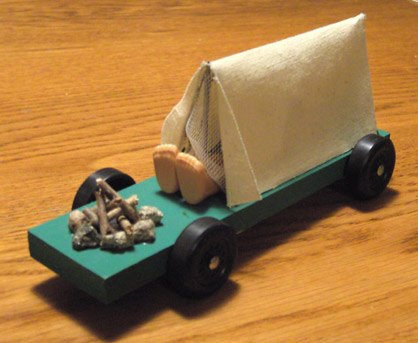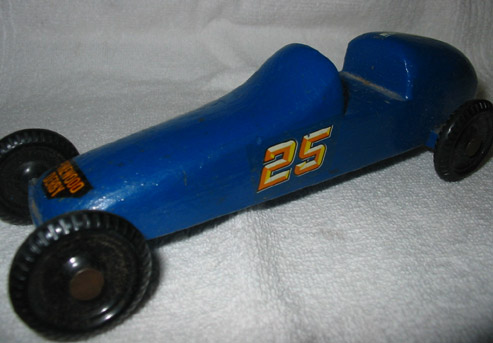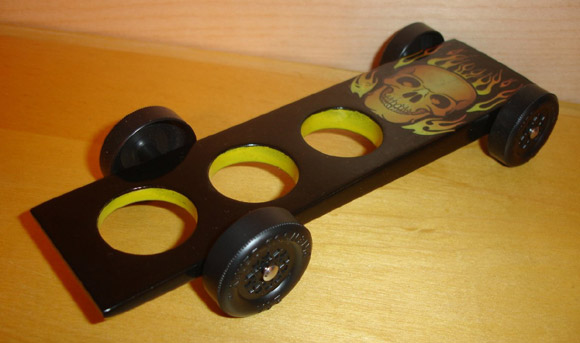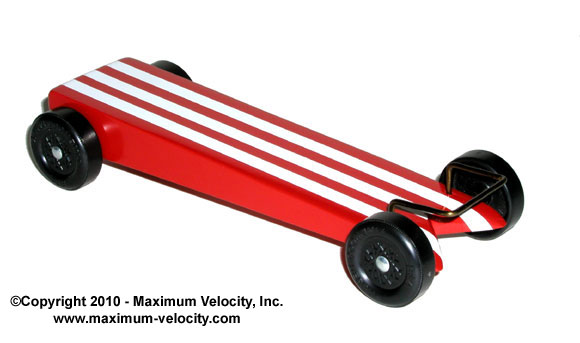– Feature Article – A Winning Philosophy
– Pinewood Derby Car Showcase
– Memory – Proud Grandpa
– Q&A
A Winning Philosophy
I originally published this article in Volume 2, Issue 5 – November 27, 2002. During the past five years, I have continued to be disappointed by the number of parents that take a “Win at all cost” viewpoint. I hope that this article will cause many to rethink their philosophy as it relates to pinewood derby racing.
Introduction
Not long ago I had a discussion with a dad about an upcoming pinewood derby race. He asked if I sold completed cars. I responded that I didn’t offer finished cars. I then went on to ask the following question: “Since the pinewood derby is intended to be a child/parent project, wouldn’t buying a completed car go against the basic spirit of the event?” The dad responded something like, “Me and my son have a ‘win at all cost’ philosophy. So we do whatever is necessary to win.” I was a bit disturbed by the comment, and tried to explain to the dad why I held a different philosophy. But I soon realized that there was little room for discussion.
What is my philosophy? Why did I react to the dad’s comment? I hope to make this clear in the article today, and in so doing I hope that I leave you with some food for thought. Your philosophy certainly does not need to match my philosophy; however, we all need to make sure that we understand our basic belief in the area of competition and ensure that it is the philosophy that we want to impart to our children.
Do Your Best
When considering life’s events, I believe that a person should strive to do their very best. In sports, this means giving a 100 percent physical effort. In educational pursuits this means studying to achieve mastery of a subject. In fact, I believe if a job is worth doing, it is worth doing well. From simple chores to running a business, I strive to do my best.
A “Do Your Best” philosophy has at its core the concept of integrity. Thus, the athlete gives one hundred percent and follows the rules of the sport; the student achieves mastery without cheating; the business- person offers a quality product for a fair price.
Furthermore, there is another aspect to a “Do Your Best” philosophy which is not so black and white. That is the idea of fair play or sportsmanship. One can abide by the rules and yet be ethically delinquent by demonstrating non-sportsmanlike conduct. The athlete may badger the competition with cruel words, use steroids or other questionable means to enhance performance. The student may use fragments of another person’s work (easy to do today with the Internet), or study a copy of last year’s test from an upperclassman. The business may make questionable product claims or slam their competition. These activities and others go against the grain of a “Do Your Best” philosophy.
Although it is not specifically stated in all cases, the “Do Your Best” philosophy is clearly in harmony with the philosophy of the major organizations that sponsor pinewood derby races:
Awana Mission Statement – “… challenge and train the youth of the world through Bible-based, Christ-centered programs …” (paraphrased)
BSA mission statement – “… to prepare young people to make ethical and moral choices over their lifetimes by instilling in them the values of the Scout Oath and Law. ” (In fact, the Cub Scout motto is “Do your best.”)
Royal Ambassadors’ Motto – “Ambassadors for Christ”
Royal Rangers Aim and Goals – “… to instruct, challenge and inspire our boys in the areas of Bible doctrine, Christian service, moral conduct , and basic beliefs of our church through interesting activities that boys enjoy.”
YMCA Mission Statement – “… to put Christian principles into practice through programs that build healthy spirit, mind, and body for all.”
How does a “Do Your Best” philosophy apply to pinewood derby racing? I believe that in the pinewood derby the child-parent team should strive to do their best. This means that they should have fun building the fastest car possible within the guidelines of the local rules, and within the boundaries of good sportsmanship. To further clarify the “Do Your Best” philosophy, let’s take a look at another philosophy.
Win At All Cost
The person who follows a “Win At All Cost” philosophy will do whatever is necessary to win, even if it means stepping into questionable, even unethical behavior. No one doubts that the ethical boundary was crossed when figure skater Nancy Kerrigan was assaulted. So certainly if a pinewood derby participant “accidentally/on-purpose” damaged a competitor’s car, the bounds of ethics would be crossed. A parent-judge that favored their child’s car would also be viewed as crossing the ethical boundary.
But how about the case where a parent has a craftsman friend build the car while the child is home playing. How about purchasing a pre-built car on eBay? Where is the ethical line crossed?
Guidelines
Clearly the purpose of the pinewood derby is both a craft-learning experience and a competition for the child. As such, the parent/child team should strive to do their best in crafting the car, and in making it go fast. To balance all of these aspects of the project can be a bit of a challenge. To help you achieve a balance, I suggest the following guidelines:
- The parent should make sure that the child is involved to the greatest extent possible in all aspects of the project, while taking into account the child’s age and capabilities. Here are some ideas for making sure that the child stays involved.
- Help the child select a design that they can build, without the parent having to do the majority of the work.
- Allow your child to do as much as they physically and safely can accomplish. This will tend to slow things down (an excellent exercise in patience for the parent!).
- Show your child the proper use of tools.
- Help your child work through the required steps (no shortcuts) and help them understand why the steps are important.
- Add strength and/or finesse for those steps that the child cannot do (initial saw cuts, drilling straight, inserting axles, etc).
- If you choose to use more sophisticated tools, supplies, techniques, keep your child engaged at each step. Help them to understand the purpose for each tool or technique, and let them use the tool whenever possible. If you have access to a machine such as a drill press or lathe, explain why the machine is being used, show your child how to use the machine, and let your child run the machine (assuming that they are at an age where they can do so safely).
- Give your child the pinewood derby building experience. Buying an “almost guaranteed district championship car” is very easy these days, but it cheats both your child and yourself out of the whole experience.
Conclusion
What is your philosophy? Do you hold to a “Do Your Best” philosophy or a “Win At All Cost” philosophy; or maybe you haven’t thought about it. If not, I encourage you to consider this question and then ensure that you are imparting to your child a philosophy that will serve them well as they grow and mature.
Pinewood Derby Car Showcase
Camping Tent: Jack Long
Camping Tent was a car I made just for fun for the 2006 pinewood derby. The tent is canvas, the poles are toothpicks, the feet are from a doll, and the fire has a red light bulb that lights up.
Old #25: Robert Mareches
I wanted to share my car with all the fine young racers. This car is probably 40 years old. My Dad and I made this car together when I was seven or eight years old. We didn’t know anything about weights or polished axles. With lots of guidance from Dad, I learned how to use a wood rasp, file, and sandpaper. The big decision was what color to paint it! He did find out that sanding the wheel diameter made it run smoother. I thought that this would be the clincher for me to win the race. Well, our car lost, but I still have fond memories of building a derby car with my Dad. The memory means more to me than winning a race; my trophy is this car. Good luck to all you fine young men in building your trophy racer.
Ghost Rider: David & Davey Sides
My 9 year old son, Davey, is very proud of the car we built. He is very enthusiastic about anything regarding Marvel Superheros and loves this particular character. Next year, he wants to made a “Wolverine” car.
Pinewood Derby Memory
Proud Grandpa
My grandson, Leo received his first pinewood derby kit in December 2007. His first reaction was, “Grandpapa, let’s build it now!” I told him that we needed to do some research and planning before we could build.
His pinewood derby was scheduled for January 12th, 2008. So we had time to do the research and planning. As part of the research, I talked to several cub scout leaders whose sons had won first place. They all provided me with great advice, and even showed me one of their son’s cars. They also suggested that I go to your web site and read your newsletters.
So we started building the kit. My grandson did the cutting, sanding and painting. I only drew the template on the block of wood and provided guidance throughout. He helped with polishing the axles and the wheels, and I did the drilling for the weight and axles.
Race time came, and my grandson was pretty excited. When we got to the event, he said to the Cubmaster, “I’m going to win!” He was the only Tiger in the Pack, so he had to race with the Bears and Wolves. They had to race three heats. He won all three heats, taking first place by a foot margin.
Next he had to race in the grand finals. There again, he had to race three heats. The race was very tight, and he ended up in third place overall . He was very excited at taking third, and I was a very proud Grandpa.
Donald J. Judeikis
Q&A
I was reading one of your responses in a recent newsletter and got confused. It seems you are suggesting to make a car at less than maximum weight. My son has a race with cars with maximum weight of 24 ounces and is only allowed to use dry graphite. Everything I read seems to suggest making the weight as close as possible to 24 oz. Are you suggesting that something less than 24 ounces might actually be better?
As I mentioned in the response, more weight does not mean more speed, it just means the car will (potentially) roll further and hold speed longer. However, a heavier car will tend to start slower. So, if the track is relatively short, you may be better off with a lighter car (starts more quickly, hopefully getting enough advantage to not allow the heavier car to catch up).
Also, graphite lube may not work as well at heavier loads – I have only tested up to 10 ounces. The wheels also may deform at this heavy of a weight, depending on the type of wheel.
The only way to really know what weight is best for the track is to build two cars, one at 24 ounces, and one at 12 ounces (for example). Alternately, build one car with the ability to hold anywhere from 12 to 24 ounces. Then do some test runs to see at what weight you get the best speed.
Our rules say “No starting devices”, but what is a starting device? Is a paper clip on the front of the car a starting device?
I believe you are referring to a “spoiler”, such as the one on this car:
The definition of a “starting device” would be up to local interpretation. I define a starting device as “a device that imparts momentum to the car, other than that supplied by gravity”. So, a magnetic front (assuming the starting pin is metal), a sticky substance on the front of the car, or any motor would be a starting device. I don’t believe a spoiler type device (such as yours) is a starting device as it does not impart momentum.
However, some people believe this type of device is a starting device. Their argument is that it is an add-on device (not part of the original kit) that helps the car to start more quickly.
Want Answers?
Do you have a pinewood derby-related question? If so, e-mail us your question.We answer all questions by e-mail, but not every question will appear in the Q&A section of the newsletter.
Back Issues
Are you a new subscriber, or have you missed some of the previous newsletters? Don’t miss out; all of the issues for Volume 5 through Volume 17 are posted on our web site.
Newsletter Contributions
We welcome your contributions. If you would like to contribute an article, a web site review, a speed tip, or a pinewood derby memory, please e-mail us.
Subscription Information
The Pinewood Derby Times is a free e-newsletter focused on pinewood derby racing. It is published biweekly from October through March.
If you haven’t already done so, please forward this issue to your pinewood derby friends. But please don’t subscribe your friends. Let them decide for themselves. Thanks.
If this newsletter was forwarded to you, why not subscribe to receive this newsletter. There is no cost, and your e-mail address is safe, as we never sell or share our distribution list.
To subscribe, send a blank e-mail to
[email protected]
You will receive a confirmation e-mail. Reply to the confirmation e-mail and you will start receiving the Pinewood Derby Times with the next issue.
Randy Davis, Editor, Pinewood Derby Times
E-Mail: [email protected]
(C)2018, Maximum Velocity, Inc. All rights reserved. Please do not reprint or place this newsletter on your web site without explicit permission. However, if you like this newsletter we grant permission, and encourage you to e-mail it to a friend.
Maximum Velocity disclaims any personal loss or liability caused by utilization of any information presented in this newsletter.
The Pinewood Derby Times is not specific to, and is not affiliated with the Boy Scouts of America, YMCA, Awana, or any other organization.
(R)Maximum Velocity is a registered trademark of Maximum Velocity, Inc.
(R)Pinewood Derby is a registered trademarks of the Boys Scouts of America.
(R)Awana is a registered trademark of Awana Clubs International.
All other names are trademarks of their respective owners.




